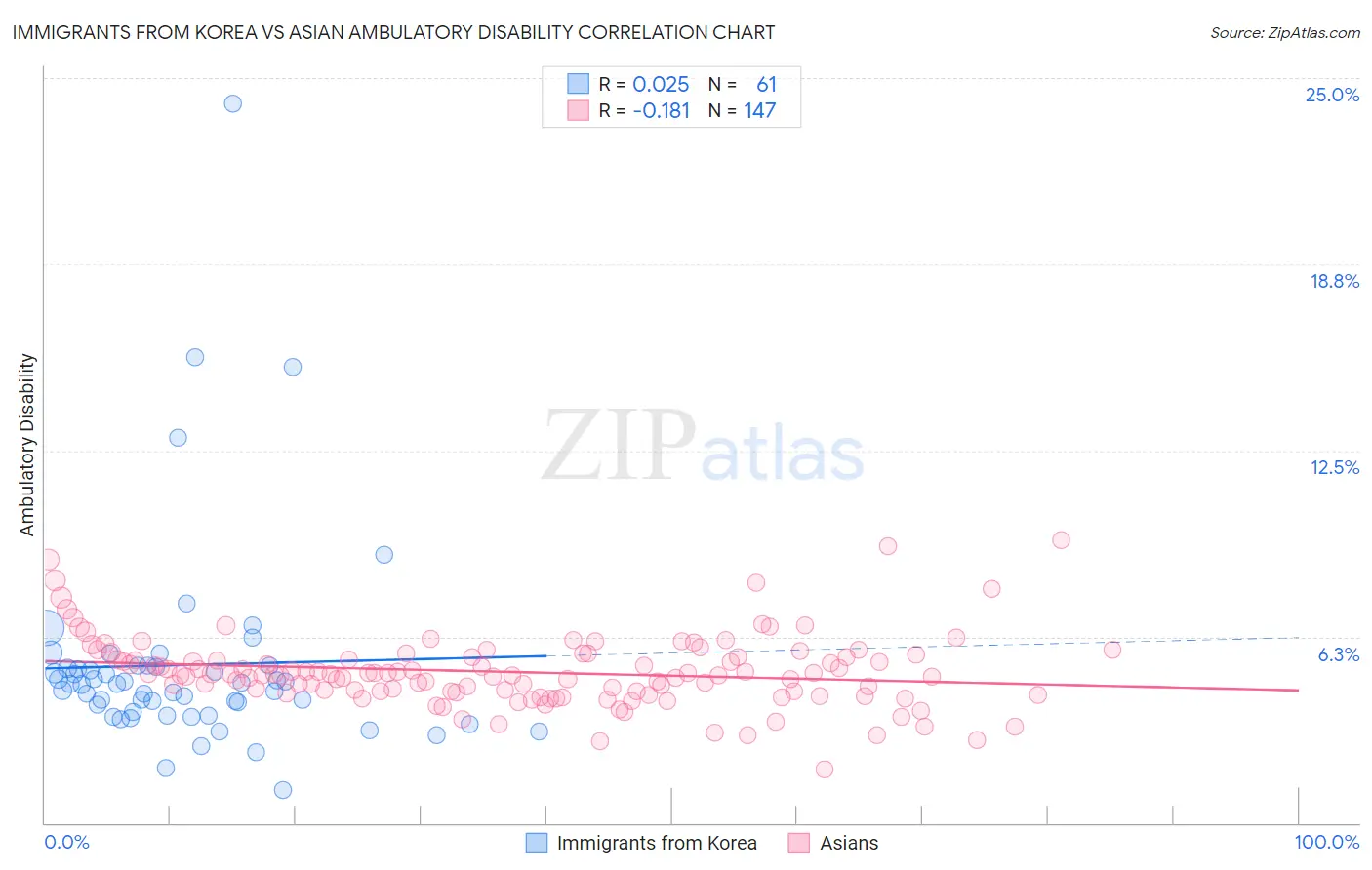Immigrants from Korea vs Asian Ambulatory Disability
COMPARE
Immigrants from Korea
Asian
Ambulatory Disability
Ambulatory Disability Comparison
Immigrants from Korea
Asians
5.2%
AMBULATORY DISABILITY
100.0/ 100
METRIC RATING
11th/ 347
METRIC RANK
5.4%
AMBULATORY DISABILITY
100.0/ 100
METRIC RATING
27th/ 347
METRIC RANK
Immigrants from Korea vs Asian Ambulatory Disability Correlation Chart
The statistical analysis conducted on geographies consisting of 416,118,040 people shows no correlation between the proportion of Immigrants from Korea and percentage of population with ambulatory disability in the United States with a correlation coefficient (R) of 0.025 and weighted average of 5.2%. Similarly, the statistical analysis conducted on geographies consisting of 550,442,799 people shows a poor negative correlation between the proportion of Asians and percentage of population with ambulatory disability in the United States with a correlation coefficient (R) of -0.181 and weighted average of 5.4%, a difference of 3.1%.

Ambulatory Disability Correlation Summary
| Measurement | Immigrants from Korea | Asian |
| Minimum | 1.1% | 1.8% |
| Maximum | 24.1% | 9.5% |
| Range | 23.0% | 7.7% |
| Mean | 5.3% | 5.1% |
| Median | 4.6% | 5.0% |
| Interquartile 25% (IQ1) | 3.7% | 4.4% |
| Interquartile 75% (IQ3) | 5.2% | 5.6% |
| Interquartile Range (IQR) | 1.6% | 1.2% |
| Standard Deviation (Sample) | 3.5% | 1.2% |
| Standard Deviation (Population) | 3.5% | 1.2% |
Demographics Similar to Immigrants from Korea and Asians by Ambulatory Disability
In terms of ambulatory disability, the demographic groups most similar to Immigrants from Korea are Okinawan (5.3%, a difference of 0.31%), Burmese (5.3%, a difference of 0.81%), Immigrants from Eastern Asia (5.3%, a difference of 0.96%), Immigrants from China (5.3%, a difference of 1.3%), and Yup'ik (5.2%, a difference of 1.6%). Similarly, the demographic groups most similar to Asians are Cambodian (5.4%, a difference of 0.060%), Immigrants from Nepal (5.4%, a difference of 0.16%), Immigrants from Iran (5.4%, a difference of 0.16%), Zimbabwean (5.4%, a difference of 0.19%), and Immigrants from Saudi Arabia (5.4%, a difference of 0.27%).
| Demographics | Rating | Rank | Ambulatory Disability |
| Iranians | 100.0 /100 | #9 | Exceptional 5.1% |
| Yup'ik | 100.0 /100 | #10 | Exceptional 5.2% |
| Immigrants | Korea | 100.0 /100 | #11 | Exceptional 5.2% |
| Okinawans | 100.0 /100 | #12 | Exceptional 5.3% |
| Burmese | 100.0 /100 | #13 | Exceptional 5.3% |
| Immigrants | Eastern Asia | 100.0 /100 | #14 | Exceptional 5.3% |
| Immigrants | China | 100.0 /100 | #15 | Exceptional 5.3% |
| Immigrants | Hong Kong | 100.0 /100 | #16 | Exceptional 5.3% |
| Immigrants | Ethiopia | 100.0 /100 | #17 | Exceptional 5.4% |
| Immigrants | Sri Lanka | 100.0 /100 | #18 | Exceptional 5.4% |
| Indians (Asian) | 100.0 /100 | #19 | Exceptional 5.4% |
| Ethiopians | 100.0 /100 | #20 | Exceptional 5.4% |
| Immigrants | Kuwait | 100.0 /100 | #21 | Exceptional 5.4% |
| Immigrants | Israel | 100.0 /100 | #22 | Exceptional 5.4% |
| Tongans | 100.0 /100 | #23 | Exceptional 5.4% |
| Immigrants | Saudi Arabia | 100.0 /100 | #24 | Exceptional 5.4% |
| Zimbabweans | 100.0 /100 | #25 | Exceptional 5.4% |
| Immigrants | Nepal | 100.0 /100 | #26 | Exceptional 5.4% |
| Asians | 100.0 /100 | #27 | Exceptional 5.4% |
| Cambodians | 100.0 /100 | #28 | Exceptional 5.4% |
| Immigrants | Iran | 100.0 /100 | #29 | Exceptional 5.4% |